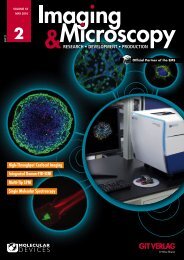SIM0216
You also want an ePaper? Increase the reach of your titles
YUMPU automatically turns print PDFs into web optimized ePapers that Google loves.
LIGHT MICROSCOPY<br />
Quality Control of<br />
Fluorescence Imaging Systems<br />
A New Tool for Performance Assessment and Monitoring<br />
Arnaud Royon 1 and Noël Converset 2<br />
We have developed a new tool for the assessment<br />
and monitoring of most of the performances of<br />
fluorescence microscopes. We believe it can advantageously<br />
be integrated in the quality control<br />
process of core facilities where a certain level of<br />
performance for the end users must be assured.<br />
Context<br />
Although performance evaluation and<br />
quality control of fluorescence microscopes<br />
is a topic that appeared more<br />
than fifteen years ago in academic laboratories<br />
[1] and national regulatory<br />
agencies [2], it is still topical as it was in<br />
the program of the Core Facility Satellite<br />
Meeting of the 15th international ELMI<br />
meeting in 2015. Due to the increasing<br />
complexity of the instrumentation used<br />
for confocal and high-end wide-field flu-<br />
orescence imaging microscopy, national<br />
metrology institutes [3], microscope<br />
manufacturers [4], and more recently<br />
core facilities [5] have gotten involved in<br />
identifying, manufacturing and/or testing<br />
different tools, both hardware and software,<br />
to assess the numerous aspects of<br />
fluorescence microscopes.<br />
On the one hand, for the core facilities,<br />
it has become obvious that quality<br />
control of fluorescence microscopes<br />
is important, as they provide a charged<br />
service to microscope end users. In this<br />
sense, they have to assure, up to a certain<br />
level, the performances of their<br />
microscopes. Quickly identifying and<br />
solving microscope issues is therefore<br />
essential in order to prevent the acquisition<br />
of corrupted data and to minimize<br />
the machine downtime. That is why core<br />
facilities usually spend tens of thousands<br />
euros per year for the maintenance of<br />
their systems.<br />
On the other hand, for the microscope<br />
manufacturers, maintenance is not as effective<br />
as it could be for two main reasons.<br />
First, in average, one intervention of<br />
the maintenance service over two is not<br />
justified, as it is based on a wrong (human<br />
misinterpretation) in situ diagnosis<br />
of the system while it performs correctly.<br />
Second, when the system is faulty, the<br />
identification and fixation of the problem<br />
can require several interventions. Knowing<br />
in advance what the microscope issue<br />
is allows optimizing the maintenance, if it<br />
is necessary. This would reduce the maintenance<br />
time and increase the technician<br />
availability for others systems/facilities.<br />
For both these actors, a win-win opportunity<br />
could arise if an evaluation and<br />
monitoring tool, accepted from both sides,<br />
24 • G.I.T. Imaging & Microscopy 2/2016



